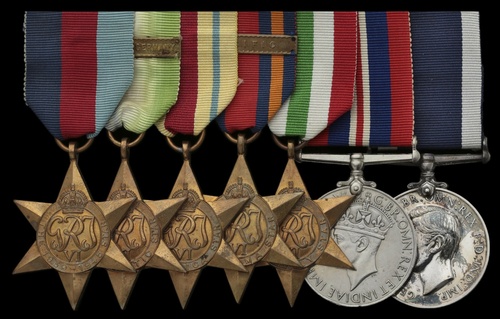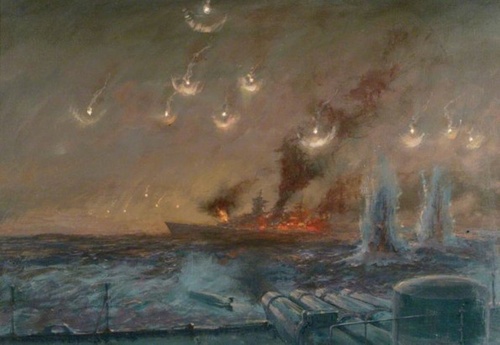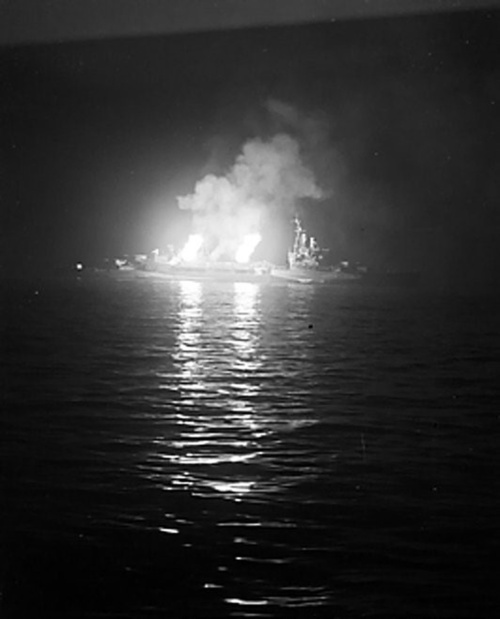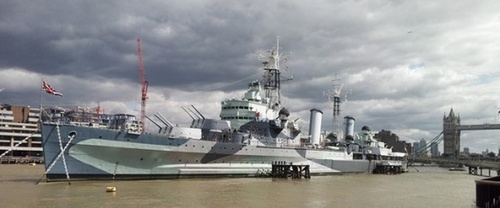Auction: 22003 - Orders, Decorations and Medals
Lot: 416
A Second World War campaign group of seven awarded to Chief Mechanician C. H. Offord, Royal Navy, who saw action in H.M.S. Belfast at the battle of North Cape in December 1943 and off Normandy in June 1944
1939-45 Star; Atlantic Star, clasp, France and Germany; Africa Star; Burma Star, clasp, Pacific; Italy Star; War Medal 1939-45; Royal Navy L.S. & G.C., G.VI.R., 1st issue (KX. 80038 C. H. Offord, Mech. 1, H.M.S. Belfast), good very fine (7)
Cecil Horace Offord was born in Ipswich, Suffolk on 5 January 1910 and entered the Royal Navy as a Stoker 2nd Class in the summer of 1929.
By the outbreak of hostilities in September 1939, he was serving as a Mechanician 1st Class in the battleship Nelson but, in November 1942, he removed to the cruiser Belfast. Remaining similarly employed until August 1944, latterly as an Acting Chief Mechanician, he was witness to Belfast's notable actions at the battle of North Cape in December 1943 and off Normandy in June 1944.
Sink the "Scharnhorst"!
On 20 December 1943, Allied convoy JW 55B, consisting of 19 merchantmen, escorted by two destroyers and three smaller warships, departed Loch Ewe, Scotland, for Murmansk, Russia.
Two days later, the convoy was spotted by German aircraft, which proceeded to shadow the convoy for the remainder of the day. Admiral Bruce Fraser, who was in charge of convoy escorts to the Arctic Sea, suspected a pending German surface attack on the convoy, likely supported by the battleship Scharnhorst. He dispatched the battleship Duke of York, the cruiser Jamaica, and four destroyers to engage the German surface fleet that might arrive at the scene; meanwhile, Rear-Admiral Robert Burnett, who was escorting the convoy at a distance with the cruisers Belfast, Norfolk, and Sheffield, was notified of Fraser's intent to seek out and destroy Scharnhorst if the German battleship presented herself.
Fraser's suspicion would turn out to be correct for, on 25 December, Scharnhorst, escorted by five destroyers, sortied from Altenfjord in Norway. Early in the morning on 26th, the German fleet searched for the convoy in poor weather. Unable to spot the Allied ships, Konteradmiral Erich Bey decided to send the destroyers southward to widen the search perimeter at the risk of leaving Scharnhorst unescorted.
Shortly after 0900 hours, the Norfolk and Sheffield detected Scharnhorst off Nordkapp (the North Cape) on the island of Magerøya in northern Norway; they opened fire at the distance of 12,000 metres, hitting Scharnhorst twice, one of which hits put her radars out of commission. Bey ordered Scharnhorst to turn south, successfully moving away from the British ships; once the British cruisers were out of sight, Scharnhorst turned north-east to approach the cruisers at a more favourable angle. Just after 1200 hours, Scharnhorst opened fire, hitting Norfolk, damaging one turret and destroying her radar. Scharnhorst then once again turned south, and this time Burnett's cruisers pursued, providing the Duke of York's group updated positions regularly. At 1615 hours, Duke of York located Scharnhorst on radar, but Scharnhorst was unaware of her arrival on the scene.
At 1648 hours, Belfast fired star shells, illuminating Scharnhorst for Duke of York. The British battleship fired at the range of 10,900 metres, scoring a hit with her first salvo, disabling Scharnhorst's forward-most turret. Another hit some time later destroyed the aircraft hangar. As Scharnhorst attempted to escape to the south, Belfast and Norfolk continued to give chase. At 1820 hours, Duke of York scored another hit on Scharnhorst, the shell detonating in the No. 1 boiler room, causing Scharnhorst's speed to decrease to 10 knots temporarily. At 1825 hours, Bey radioed the message "We will fight on until the last shell is fired." At 1850, our destroyers caught up with Scharnhorst, scoring gun and torpedo hits. Duke of York and Jamaica attacked at about 1900 hours at the range of 9,500 metres, and at 1915 hours Belfast joined in as well. Already heavily damaged, Scharnhorst suffered another round of multiple torpedo hits and finally sank at 1945 hours. Of her complement of nearly 2,000, only 36 were rescued; Admiral Bey was not among them.
For an informative film highlighting Belfast's part in the Scharnhorst action, as released by the Imperial War Museum in June 2021, see:
https://www.youtube.com/watch?v=eUnoAqD2a0o
Normandy
By way of summary in respect of Belfast's subsequent part in the Normandy landings, the following extracts have been taken from The King's Cruisers, by Norman Holmes:
'From the headquarters ship, H.M.S. Hilary, I both saw and heard the Belfast in action, day after day, as the army consolidated its positions ashore. She was firing with speed and accuracy when the smoke of the German batteries could still be seen from the Allied anchorage, and she was still pounding the enemy at long range when H.M. the King set foot in France ten days later.
Her powerful guns were among six hundred that poured a sheet of covering fire over the assault troops, and their sharp crack, reverberating from the shore, provided a reassuring overture for those who followed after. In a despatch from the anchorage on D-plus-3 I wrote: "At this moment H.M.S. Belfast, only a few hundred yards away, is firing salvoes at a rate of about one a minute. Her guns are at a high elevation, and the shells, screaming to their destination, pass out of hearing of the thousands of British troops below. But somewhere in the region of Caen, perhaps, they will fall with deadly accuracy on German troop and tank concentrations." On the previous night Belfast had been firing with tracer shells interspersed, and I recorded that "it was an amazing sight to see them soar higher and higher until they disappeared, to fall far beyond our range of vision".
By D-plus-4 it was estimated that Allied warships had fired not less than 100,000 shells in an unprecedented bombardment from the sea. Navy, Army and R.A.F. all worked together in spotting and finding new targets for the naval guns. The way such guns as those of the Belfast were able to pinpoint distant targets proved an eye-opener to the soldiers on the shore. They soon lost their initial shyness about calling fore fire from the ships in the anchorage, even when our forces were close to those of the enemy … some of the shells we used gave off a distinct colour on bursting in order to facilitate the work of the spotters … '
Belfast - flying the flag of Vice-Admiral F. H. G. Dalrymple-Hamilton - also lent valuable support to the 3rd Canadian Division, the firepower of one of her 6-inch guns being equivalent to a medium regiment of artillery.
Postscript
Having parted company with Belfast in August 1944, Offord ended the war aboard the battleship King George V in the Far East. He was finally pensioned ashore in January 1953.
But by way of posterity, his wartime footsteps may today be followed aboard Belfast at Tower Bridge, where she is in the care of the Imperial War Museum.
Subject to 20% VAT on Buyer’s Premium. For more information please view Terms and Conditions for Buyers.
Sold for
£650
Starting price
£160











